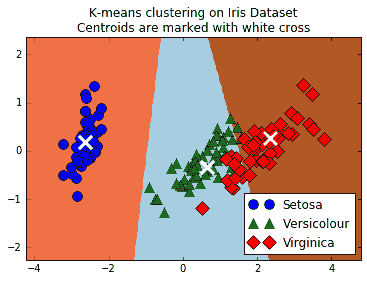# 使用 k 均值聚類
TensorFlow 還可用于實現迭代聚類算法,例如 k-means。在本文中,我們展示了在`iris`數據集上使用 k-means 的示例。
## 做好準備
我們在本書中探討的幾乎所有機器學習模型都是監督模型。 TensorFlow 非常適合這些類型的問題。但是,如果我們愿意,我們也可以實現無人監督的模型。例如,此秘籍將實現 k-means 聚類。
我們將實現聚類的數據集是`iris`數據集。這是一個很好的數據集的原因之一是因為我們已經知道有三種不同的目標(三種類型的鳶尾花)。這讓我們知道我們正在尋找數據中的三個不同的集群。
我們將`iris`數據集聚類為三組,然后將這些聚類的準確率與實際標簽進行比較。
## 操作步驟
1. 首先,我們加載必要的庫。我們還從`sklearn`加載了一些 PCA 工具,以便我們可以將結果數據從四維更改為二維,以實現可視化目的:
```py
import numpy as np
import matplotlib.pyplot as plt
import tensorflow as tf
from sklearn import datasets
from scipy.spatial import cKDTree
from sklearn.decomposition import PCA
from sklearn.preprocessing import scale
```
1. 我們啟動圖會話,并加載`iris`數據集:
```py
sess = tf.Session()
iris = datasets.load_iris()
num_pts = len(iris.data)
num_feats = len(iris.data[0])
```
1. 我們現在將設置組,代,并創建圖所需的變量:
```py
k=3
generations = 25
data_points = tf.Variable(iris.data)
cluster_labels = tf.Variable(tf.zeros([num_pts], dtype=tf.int64))
```
1. 我們需要的下一個變量是每組的質心。我們將通過隨機選擇`iris`數據集的三個不同點來初始化 k-means 算法的質心:
```py
rand_starts = np.array([iris.data[np.random.choice(len(iris.data))] for _ in range(k)])
centroids = tf.Variable(rand_starts)
```
1. 現在,我們需要計算每個數據點和每個`centroids`之間的距離。我們通過將`centroids`擴展為矩陣來實現這一點,對數據點也是如此。然后我們將計算兩個矩陣之間的歐幾里德距離:
```py
centroid_matrix = tf.reshape(tf.tile(centroids, [num_pts, 1]), [num_pts, k, num_feats])
point_matrix = tf.reshape(tf.tile(data_points, [1, k]), [num_pts, k, num_feats])
distances = tf.reduce_sum(tf.square(point_matrix - centroid_matrix), reduction_indices=2)
```
1. `centroids`賦值是每個數據點最接近的`centroids`(最小距離):
```py
centroid_group = tf.argmin(distances, 1)
```
1. 現在,我們必須計算組平均值以獲得新的質心:
```py
def data_group_avg(group_ids, data):
# Sum each group
sum_total = tf.unsorted_segment_sum(data, group_ids, 3)
# Count each group
num_total = tf.unsorted_segment_sum(tf.ones_like(data), group_ids, 3)
# Calculate average
avg_by_group = sum_total/num_total
return(avg_by_group)
means = data_group_avg(centroid_group, data_points)
update = tf.group(centroids.assign(means), cluster_labels.assign(centroid_group))
```
1. 接下來,我們初始化模型變量:
```py
init = tf.global_variables_initializer()
sess.run(init)
```
1. 我們將遍歷幾代并相應地更新每個組的質心:
```py
for i in range(generations):
print('Calculating gen {}, out of {}.'.format(i, generations))
_, centroid_group_count = sess.run([update, centroid_group])
group_count = []
for ix in range(k):
group_count.append(np.sum(centroid_group_count==ix))
print('Group counts: {}'.format(group_count))
```
1. 這導致以下輸出:
```py
Calculating gen 0, out of 25\. Group counts: [50, 28, 72] Calculating gen 1, out of 25\. Group counts: [50, 35, 65] Calculating gen 23, out of 25\. Group counts: [50, 38, 62] Calculating gen 24, out of 25\. Group counts: [50, 38, 62]
```
1. 為了驗證我們的聚類,我們可以使用聚類進行預測。我們現在看到有多少數據點位于相同虹膜種類的相似簇中:
```py
[centers, assignments] = sess.run([centroids, cluster_labels])
def most_common(my_list):
return(max(set(my_list), key=my_list.count))
label0 = most_common(list(assignments[0:50]))
label1 = most_common(list(assignments[50:100]))
label2 = most_common(list(assignments[100:150]))
group0_count = np.sum(assignments[0:50]==label0)
group1_count = np.sum(assignments[50:100]==label1)
group2_count = np.sum(assignments[100:150]==label2)
accuracy = (group0_count + group1_count + group2_count)/150\.
print('Accuracy: {:.2}'.format(accuracy))
```
1. 這導致以下輸出:
```py
Accuracy: 0.89
```
1. 為了直觀地看到我們的分組,如果它們確實已經分離出`iris`物種,我們將使用 PCA 將四維轉換為二維,并繪制數據點和組。在 PCA 分解之后,我們在 x-y 值網格上創建預測,以繪制顏色圖:
```py
pca_model = PCA(n_components=2)
reduced_data = pca_model.fit_transform(iris.data)
# Transform centers
reduced_centers = pca_model.transform(centers)
# Step size of mesh for plotting
h = .02
x_min, x_max = reduced_data[:, 0].min() - 1, reduced_data[:, 0].max() + 1
y_min, y_max = reduced_data[:, 1].min() - 1, reduced_data[:, 1].max() + 1
xx, yy = np.meshgrid(np.arange(x_min, x_max, h), np.arange(y_min, y_max, h))
# Get k-means classifications for the grid points
xx_pt = list(xx.ravel())
yy_pt = list(yy.ravel())
xy_pts = np.array([[x,y] for x,y in zip(xx_pt, yy_pt)])
mytree = cKDTree(reduced_centers)
dist, indexes = mytree.query(xy_pts)
indexes = indexes.reshape(xx.shape)
```
1. 并且,這里是`matplotlib`代碼將我們的發現結合在一個繪圖上。這個密碼的繪圖部分很大程度上改編自 scikit-learn( [http://scikit-learn.org/](http://scikit-learn.org/) )文檔網站上的演示( [http://scikit-learn.org/ stable / auto_examples / cluster / plot_kmeans_digits.html](http://scikit-learn.org/stable/auto_examples/cluster/plot_kmeans_digits.html) ):
```py
plt.clf()
plt.imshow(indexes, interpolation='nearest',
extent=(xx.min(), xx.max(), yy.min(), yy.max()),
cmap=plt.cm.Paired,
aspect='auto', origin='lower')
# Plot each of the true iris data groups
symbols = ['o', '^', 'D']
label_name = ['Setosa', 'Versicolour', 'Virginica']
for i in range(3):
temp_group = reduced_data[(i*50):(50)*(i+1)]
plt.plot(temp_group[:, 0], temp_group[:, 1], symbols[i], markersize=10, label=label_name[i])
# Plot the centroids as a white X
plt.scatter(reduced_centers[:, 0], reduced_centers[:, 1],
marker='x', s=169, linewidths=3,
color='w', zorder=10)
plt.title('K-means clustering on Iris Datasets'
'Centroids are marked with white cross')
plt.xlim(x_min, x_max)
plt.ylim(y_min, y_max)
plt.legend(loc='lower right')
plt.show()
```
這個繪圖代碼將向我們展示三個類,三個類的預測空間以及每個組的質心:

圖 5:顯示 k-means 的無監督分類算法的屏幕截圖;可以用來將三種鳶尾花種組合在一起。三個 k-means 組是三個陰影區域,三個不同的點(圓,三角形和菱形)是三個真正的物種分類
## 更多
對于此秘籍,我們使用 TensorFlow 將`iris`數據集聚類為三組。然后,我們計算了落入相似組的數據點的百分比(89%),并繪制了所得 k-均值組的圖。由于 k-means 作為分類算法是局部線性的(線性分離器向上),因此很難學習虹膜鳶尾和 Iris virginica 之間的天然非線性邊界。但是,一個優點是 k-means 算法根本不需要標記數據來執行。
- TensorFlow 入門
- 介紹
- TensorFlow 如何工作
- 聲明變量和張量
- 使用占位符和變量
- 使用矩陣
- 聲明操作符
- 實現激活函數
- 使用數據源
- 其他資源
- TensorFlow 的方式
- 介紹
- 計算圖中的操作
- 對嵌套操作分層
- 使用多個層
- 實現損失函數
- 實現反向傳播
- 使用批量和隨機訓練
- 把所有東西結合在一起
- 評估模型
- 線性回歸
- 介紹
- 使用矩陣逆方法
- 實現分解方法
- 學習 TensorFlow 線性回歸方法
- 理解線性回歸中的損失函數
- 實現 deming 回歸
- 實現套索和嶺回歸
- 實現彈性網絡回歸
- 實現邏輯回歸
- 支持向量機
- 介紹
- 使用線性 SVM
- 簡化為線性回歸
- 在 TensorFlow 中使用內核
- 實現非線性 SVM
- 實現多類 SVM
- 最近鄰方法
- 介紹
- 使用最近鄰
- 使用基于文本的距離
- 使用混合距離函數的計算
- 使用地址匹配的示例
- 使用最近鄰進行圖像識別
- 神經網絡
- 介紹
- 實現操作門
- 使用門和激活函數
- 實現單層神經網絡
- 實現不同的層
- 使用多層神經網絡
- 改進線性模型的預測
- 學習玩井字棋
- 自然語言處理
- 介紹
- 使用詞袋嵌入
- 實現 TF-IDF
- 使用 Skip-Gram 嵌入
- 使用 CBOW 嵌入
- 使用 word2vec 進行預測
- 使用 doc2vec 進行情緒分析
- 卷積神經網絡
- 介紹
- 實現簡單的 CNN
- 實現先進的 CNN
- 重新訓練現有的 CNN 模型
- 應用 StyleNet 和 NeuralStyle 項目
- 實現 DeepDream
- 循環神經網絡
- 介紹
- 為垃圾郵件預測實現 RNN
- 實現 LSTM 模型
- 堆疊多個 LSTM 層
- 創建序列到序列模型
- 訓練 Siamese RNN 相似性度量
- 將 TensorFlow 投入生產
- 介紹
- 實現單元測試
- 使用多個執行程序
- 并行化 TensorFlow
- 將 TensorFlow 投入生產
- 生產環境 TensorFlow 的一個例子
- 使用 TensorFlow 服務
- 更多 TensorFlow
- 介紹
- 可視化 TensorBoard 中的圖
- 使用遺傳算法
- 使用 k 均值聚類
- 求解常微分方程組
- 使用隨機森林
- 使用 TensorFlow 和 Keras
